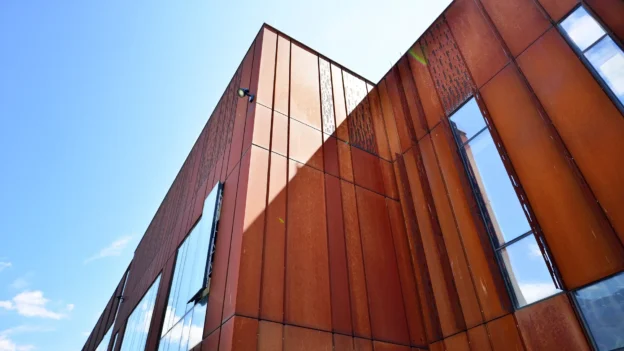Corten steel, also known as weathering steel or patinable steel, has been specifically synthesized to resist atmospheric corrosion in exposed environments. Unlike conventional carbon steel, this material contains an alloy of copper, chromium, nickel, phosphorus, and silicon, which gives it the ability to form a stable passive layer against oxidation. This surface oxide, far from being a sign of deterioration, acts as a protective barrier that limits the access of oxygen, moisture, and contaminants to the base metal.
What is Corten steel?
Corten steel is a low-alloy steel that falls between common carbon steel and stainless steel in terms of durability and strength properties. Its name comes from the combination of the English terms corrosion, resistance, and tensile strength, referring to its high resistance to corrosion and traction.
Its chemical composition includes copper (Cu), which promotes the formation of stable oxides; chromium (Cr), which improves patina adhesion; nickel (Ni), which increases electrochemical stability; and phosphorus (P), which refines the surface microstructure. Thanks to this formulation, Corten steel is 2 to 8 times more resistant to atmospheric corrosion than conventional carbon steel, and offers additional advantages such as extended service life, reduced maintenance costs, and improved performance against environmental fatigue.
Protection mechanism and formation conditions
The anti-corrosive mechanism of Corten steel is based on the gradual formation of a protective patina. When exposed to the atmosphere, the steel begins a process of oxidation similar to that of any common steel. However, the alloying elements modify the growth of the oxide, favoring the creation of a dense, compact, and adherent film that limits the penetration of contaminants and moisture.
For this patina to reach stability, certain conditions must be met: alternating cycles of moisture and drying, atmospheres with moderate pollutants, and adequate ventilation. In such scenarios, the protective layer develops over a period of 18 to 36 months and largely stops the progression of corrosion. However, in marine environments with high chloride content or in areas of constant humidity, the film fails to stabilize, leading to problems of localized perforation and premature loss of material.
Regulations and technical classification
Corten steel is produced under international standards that define its mechanical and compositional properties. One of the most widely recognized is ASTM A588, which establishes a minimum yield strength of 50 ksi (345 MPa) and a tensile strength of up to 70 ksi for thicknesses less than 4 inches. On the other hand, ASTM A242, a pioneer in the introduction of this material, covers applications in bridges, housing structures, and freight cars.
There are different grades and variants, such as Corten A, which has a higher phosphorus content and is used in urban architecture and facades, and Corten B, which has greater mechanical strength and is used in transport structures, bridges, and cranes. These classifications allow the appropriate material to be selected according to the type of exposure and structural requirements.
Key features and benefits of Corten steel
ASTM A588 steel, also known as Corten steel, is distinguished by a unique combination of mechanical strength, durability, and aesthetic appeal. Its main characteristics include:
- Superior resistance to atmospheric corrosion: Thanks to the addition of copper and other alloying elements, A588 steel develops a protective patina with a stable rust-like appearance. This surface layer acts as a barrier against moisture and oxygen, significantly reducing the progression of corrosion and eliminating the need for additional coatings. Its performance against atmospheric corrosion far exceeds the performance of conventional steels such as A36 and A572-50, even in aggressive environments.
- High strength and structural durability: A588 steel has high tensile strength and great toughness, allowing it to withstand heavy loads and dynamic stresses. These properties make it an ideal choice for infrastructure subjected to demanding conditions, such as bridges, high-rise buildings, or construction equipment. With proper maintenance, structures made from this steel achieve a long and reliable service life.
- Aesthetic value and architectural design: In addition to its functional advantages, ASTM A588 steel provides a distinctive finish thanks to its warm tones and rough texture created by patina. This natural aged appearance blends harmoniously into modern and artistic architectural projects, which has boosted its use in facades, sculptures, and ornamental applications.
ASTM A588 steel applications
ASTM A588 steel is widely used in infrastructure projects and architectural design due to its versatility and weather resistance. Some of its most notable applications are:
- Bridges: Its high structural strength and ability to withstand exposed environments, such as coastal areas or industrial settings, make A588 a popular choice in bridge construction. Reduced maintenance due to corrosion contributes to greater long-term cost-effectiveness and safety.
- Urban architecture and industry: From skyscrapers to residential buildings, this steel is used in curtain walls, roofs, and facade systems. Its distinctive appearance enhances the aesthetic value of architectural projects while offering solid protection against environmental deterioration.
- Outdoor structures: Stadiums, pavilions, and outdoor theaters benefit from the durability and resistance of A588 steel in extreme weather conditions. Its performance makes it a reliable choice for projects that require structural safety without sacrificing design.
- Construction machinery and equipment: Components subjected to intense stress, such as loader arms, chassis, or excavator buckets, find A588 steel to be an ideal material. Its resistance to abrasion and corrosion extends the service life of equipment and optimizes its operational performance.
The appeal of Corten steel lies not only in its resistance to atmospheric corrosion, but also in its unique aesthetic. The chromatic evolution of its surface, which varies from orange to dark brown tones, makes it a highly valued material in urban architecture, landscaping, and outdoor furniture. Notable examples include sculptures such as the Chicago Picasso and contemporary structures such as the Barclays Center in New York.
In the industrial sector, Corten steel is used in bridges, railways, intermodal containers, offshore platforms, photovoltaic stations, and road structures, where environmental exposure requires durable, low-maintenance materials. Its use in urban and industrial environments demonstrates that it can offer a balance between mechanical strength, durability, and long-term cost savings.
Differences compared to conventional carbon steel
Common carbon steel requires protective coatings, as its surface rust is porous and easily detached, accelerating deterioration. In contrast, Corten steel develops an inherent protection system, which significantly reduces the need for paint or additional coatings. This provides an economic and operational advantage, as it lowers maintenance costs and extends the useful life of exposed structures.
In addition, Corten steel offers environmental benefits as it is 100% recyclable and eliminates the need for chemicals associated with coating processes. This makes it a sustainable alternative that is aligned with modern green building standards and environmental certifications.
New research on Corten steel
Recent research has advanced toward the nanometric characterization of patina to determine how alloying elements influence the stability of the oxides formed. Studies using Raman spectroscopy and X-ray diffraction have shown that the proportion of copper- and chromium-rich oxides determines the adhesion of the protective film.
On the other hand, hybrid surface treatments have been developed that combine the natural patination process with organic-based corrosion inhibitors, which broadens the range of applications for Corten steel in marine environments. Research is also being conducted into the incorporation of microalloys with molybdenum and vanadium, aimed at improving resistance to industrial atmospheres with high concentrations of sulfur dioxide.
Conclusion
Corten steel is a highly relevant technological and aesthetic solution in contemporary engineering and architecture. Its ability to generate a protective passive layer that remains stable in urban and industrial environments, its superior durability compared to conventional steel, and its low maintenance cost make it the material of choice for long-lasting exposed structures. However, its performance depends directly on environmental conditions, making a technical analysis essential prior to its application in critical projects.
References
- ASTM International. (2019). ASTM A588/A588M-19: Standard Specification for High-Strength Low-Alloy Structural Steel, up to 50 ksi Minimum Yield Point, with Atmospheric Corrosion Resistance. ASTM.
- ASTM International. (2018). ASTM A242/A242M-18: Standard Specification for High-Strength Low-Alloy Structural Steel. ASTM.
- Kawano, K., & Misawa, T. (2020). Corrosion behavior of weathering steels in various atmospheres. Corrosion Science, 172, 108701.
- Yamashita, M., et al. (2019). Stability of rust layers on weathering steel studied by advanced surface analysis. Journal of Materials Engineering and Performance, 28(1), 3-12.
FAQs
What is Corten steel?
It is a low-alloy steel containing copper, chromium, nickel, and phosphorus, which forms a protective patina that is resistant to atmospheric corrosion.
How does it protect your surface against corrosion?
It generates a film of compact, adherent oxides that act as a barrier against moisture, oxygen, and contaminants.
Under what conditions does it form its protective patina?
In urban and industrial atmospheres with cycles of humidity and drying. Not recommended in marine environments or in conditions of permanent humidity.
Where is this type of steel commonly used?
In urban architecture, outdoor furniture, sculptures, bridges, containers, platforms, and exposed industrial structures.
What makes it different from conventional carbon steel?
Unlike ordinary steel, it does not require additional coatings, offers greater durability, and reduces maintenance costs throughout its service life.


